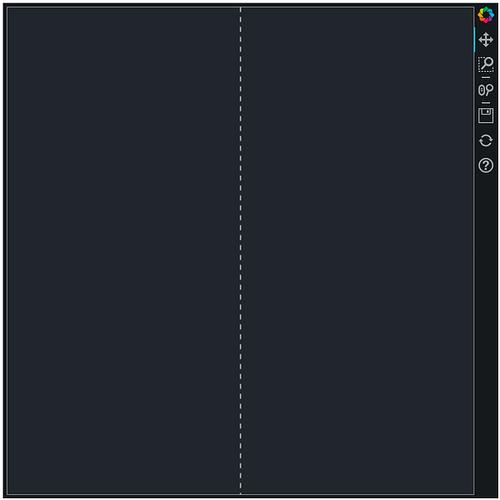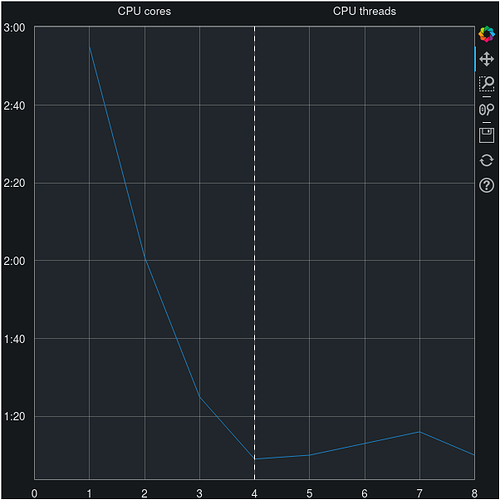Code:
import time
from bokeh.io import curdoc
from bokeh.plotting import figure, show
from bokeh.models import LinearAxis, Span
processes, seconds = [], []
for line in ['1 2:55',
'2 2:01',
'3 1:25',
'4 1:09',
'5 1:10',
'6 1:13',
'7 1:16',
'8 1:10']:
row = line.rstrip().split('\t')
processes.append(int(row[0]))
seconds.append(time.strptime(row[1],
'%H:%M'))
curdoc().theme = 'dark_minimal'
p = figure(x_axis_label='Parallel processes',
y_axis_label='Time',
x_range=(0, processes[-1]))
cores_label_place = processes[-1] // 4
threads_label_place = processes[-1] - cores_label_place
p.add_layout(LinearAxis(ticker=[cores_label_place,
threads_label_place],
major_label_overrides={cores_label_place: 'CPU cores',
threads_label_place: 'CPU threads'}),
'above')
p.add_layout(Span(location=processes[-1] / 2,
dimension='height',
line_dash='dashed',
line_color='white'))
p.line(processes, seconds)
show(p)
Result:
Neither the main axis labels, nor the additional axis labels, nor the main line are displayed. But the span line is shown.
Plotted objects:
[1, 2, 3, 4, 5, 6, 7, 8]
[time.struct_time(tm_year=1900, tm_mon=1, tm_mday=1, tm_hour=2, tm_min=55, tm_sec=0, tm_wday=0, tm_yday=1, tm_isdst=-1), time.struct_time(tm_year=1900, tm_mon=1, tm_mday=1, tm_hour=2, tm_min=1, tm_sec=0, tm_wday=0, tm_yday=1, tm_isdst=-1), time.struct_time(tm_year=1900, tm_mon=1, tm_mday=1, tm_hour=1, tm_min=25, tm_sec=0, tm_wday=0, tm_yday=1, tm_isdst=-1), time.struct_time(tm_year=1900, tm_mon=1, tm_mday=1, tm_hour=1, tm_min=9, tm_sec=0, tm_wday=0, tm_yday=1, tm_isdst=-1), time.struct_time(tm_year=1900, tm_mon=1, tm_mday=1, tm_hour=1, tm_min=10, tm_sec=0, tm_wday=0, tm_yday=1, tm_isdst=-1), time.struct_time(tm_year=1900, tm_mon=1, tm_mday=1, tm_hour=1, tm_min=13, tm_sec=0, tm_wday=0, tm_yday=1, tm_isdst=-1), time.struct_time(tm_year=1900, tm_mon=1, tm_mday=1, tm_hour=1, tm_min=16, tm_sec=0, tm_wday=0, tm_yday=1, tm_isdst=-1), time.struct_time(tm_year=1900, tm_mon=1, tm_mday=1, tm_hour=1, tm_min=10, tm_sec=0, tm_wday=0, tm_yday=1, tm_isdst=-1)]


